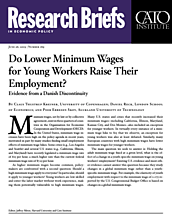As higher minimum wages become common, policymakers are confronted with a second question: Should a high minimum wage apply to everyone? In particular, should it apply to younger workers? Young workers are low skilled and enter the labor market without work experience, making them potentially vulnerable to high minimum wages. Many U.S. states and cities that recently increased their minimum wages — including California, Illinois, Maryland, Kansas City, and Des Moines — also included an exception for younger workers. In virtually every instance of a minimum wage hike to $15 that we observe, an exception for young workers was also at least debated. Similarly, many European countries with high minimum wages have lower minimum wages for younger workers.
The main question we seek to answer is: Holding the adult minimum wage fixed at a given level, what is the effect of a change in a youth-specific minimum wage on young workers’ employment? Existing U.S. evidence and most other evidence cannot answer this question because they study changes in a global minimum wage rather than a youth-specific minimum wage. For example, the elasticity of youth employment with respect to the minimum wage of 0.075 reported by the U.S. Congressional Budget Office is based on changes in a global minimum wage.
Our empirical evidence exploits a large discontinuity in Danish minimum wage rules occurring when workers reach age 18. The Danish context is ideal for our purpose. Denmark has large changes in minimum wage rates when workers turn 18 (and no change at any other ages) and a high adult minimum wage comparable to the $15 level in California and under consideration more generally in the United States. Furthermore, we can study the effect of the age discontinuity using high-quality monthly data on wages, employment, and hours worked for the entire Danish workforce.
Our main findings are contained in Figure 1, which shows that the age discontinuity in minimum wages has a large impact on employment at around age 18. Figure 1‑A plots average hourly wages, imputed by dividing reported monthly wages by reported hours worked for each individual, as a function of age (measured in months) for both two years before and after their 18th birthdays. The average hourly wage rate jumps by 46 krones (DKK), or about $7, corresponding to a 40 percent change in the wage level at age 18. Figure 1‑B plots the share of individuals who are employed by monthly age. We observe a 15 percentage-point decrease in employment at age 18, which corresponds to a 33 percent decrease in the number of employed individuals. For comparison, note that the wage and employment rates develop smoothly when individuals turn 17 and 19 years old, and that it takes two years before the employment rate is back at the level it attains just before the jump downward at age 18. Subsequent analyses reveal that the drop in employment when workers turn 18 reflects a discrete change in job loss without any discrete change in hiring. (We do observe a small anticipatory slowdown in hiring as workers approach age 18.)
A simple estimate of the employment elasticity with respect to the wage change is obtained by dividing the estimates of the percentage changes in employment and hourly wage. This gives an elasticity of around 0.8. When looking at total hours worked, we find an elasticity of 1.1. Recall that a unit elasticity would imply that the average wage payment of all individuals, including both employed and non-employed workers, should stay unchanged when the wage rate is raised, because its effect on the average wage payment is fully offset by a decrease in employment. Consistent with this reasoning, we find nearly no effect on average earnings. This provides alternative evidence of a total-hours-worked elasticity of around 1.0, not depending on the measurement of hourly wages.
Additional analysis demonstrates that our interpretation of the empirical results is correct and studies heterogeneity in employment effects across workers. Most importantly, we demonstrate that other policies that change when workers turn 18, such as the eligibility for Danish social-welfare programs, are not driving our results. We also show that the size of the employment elasticity is only slightly larger for workers of lower ability, as proxied by school grade point average in ninth grade or the income of parents. Finally, we provide suggestive evidence that job losses have persistent effects on workers. Two years after the workers’ 18th birthdays, the employment rate is about 15 percentage points lower for workers who lost their jobs at age 18 relative to workers who kept their jobs.
NOTE:
This research brief is based on Claus Thustrup Kreiner, Daniel Reck, and Peer Ebbesen Skov, “Do Lower Minimum Wages for Young Workers Raise Their Employment? Evidence from a Danish Discontinuity,” Review of Economics and Statistics, March 4, 2019, https://www.mitpressjournals.org/doi/abs/10.1162/rest_a_00825.

